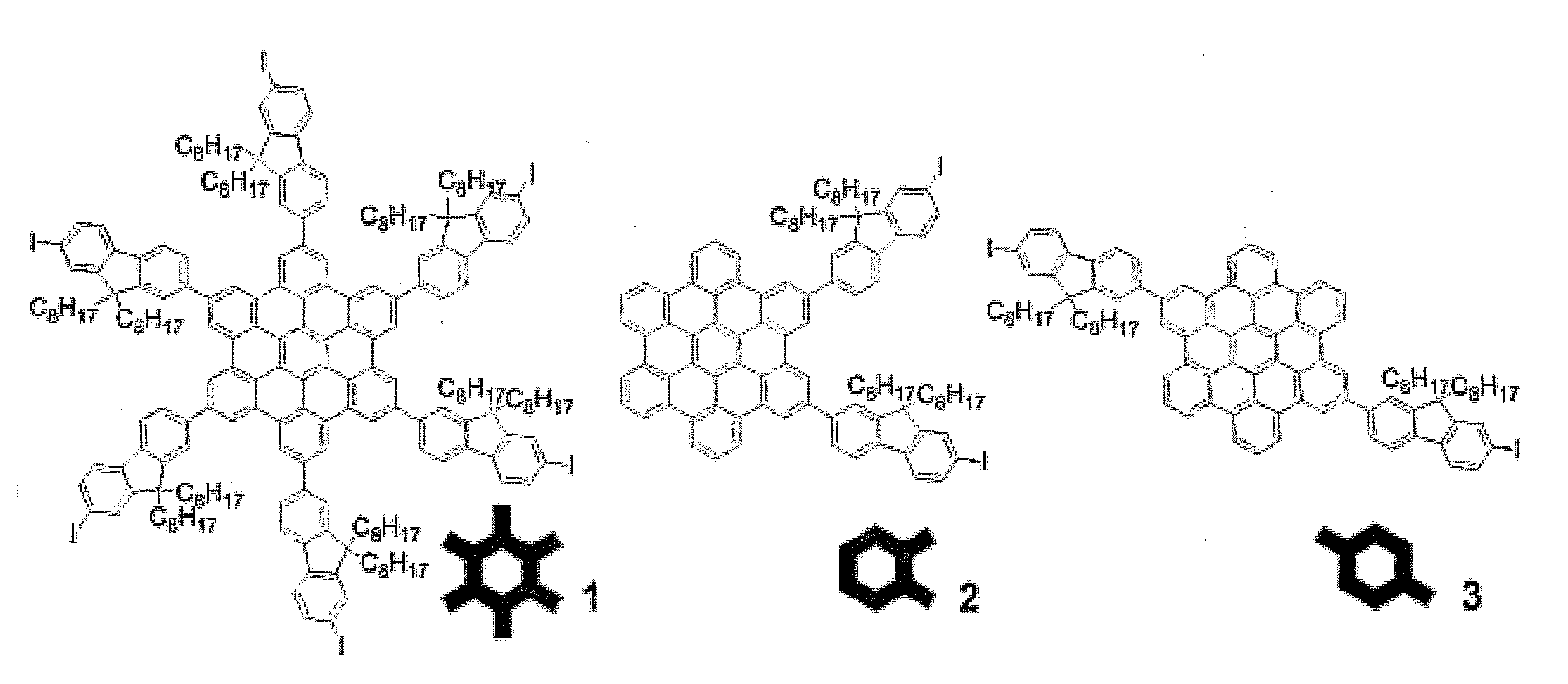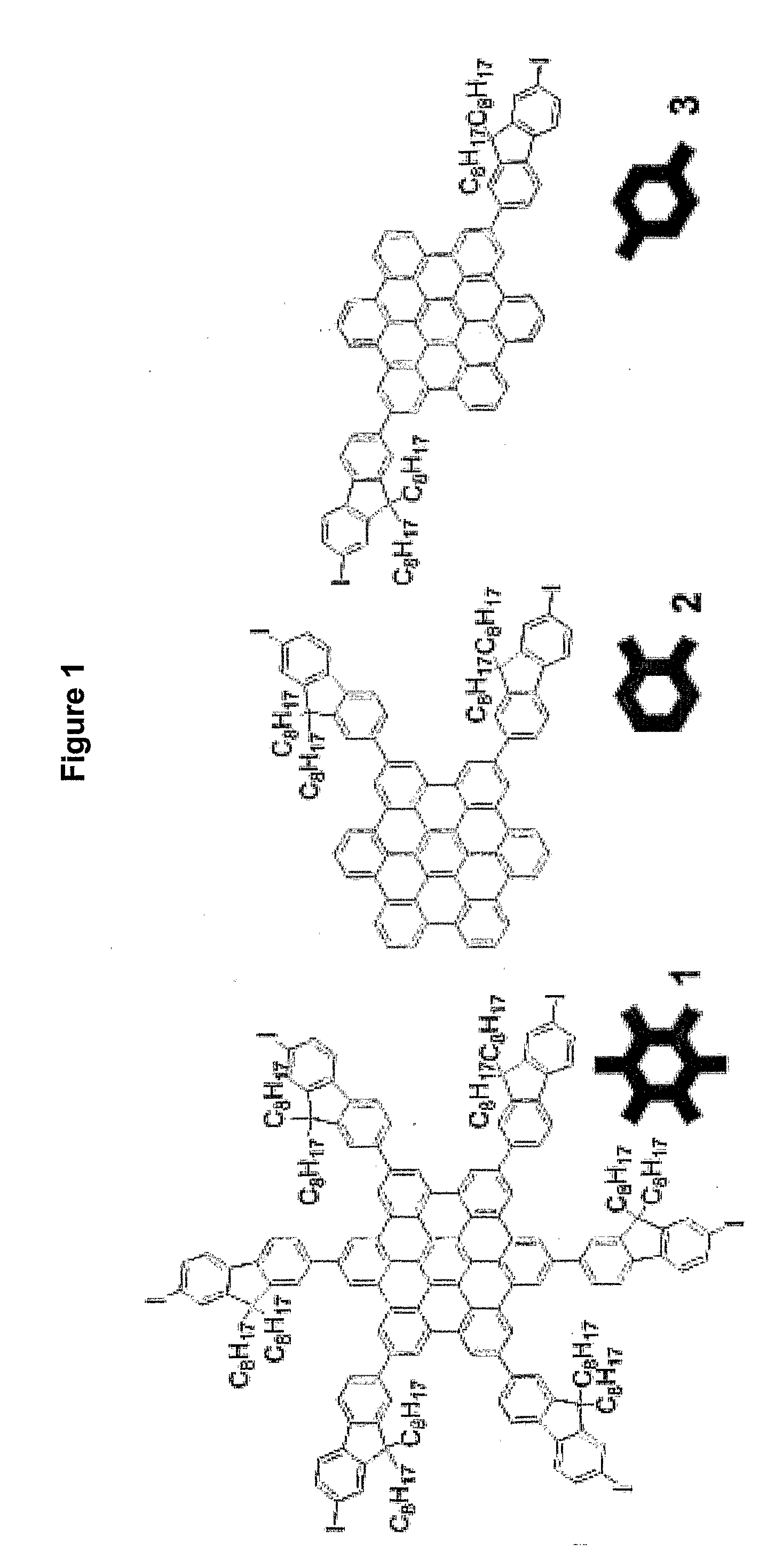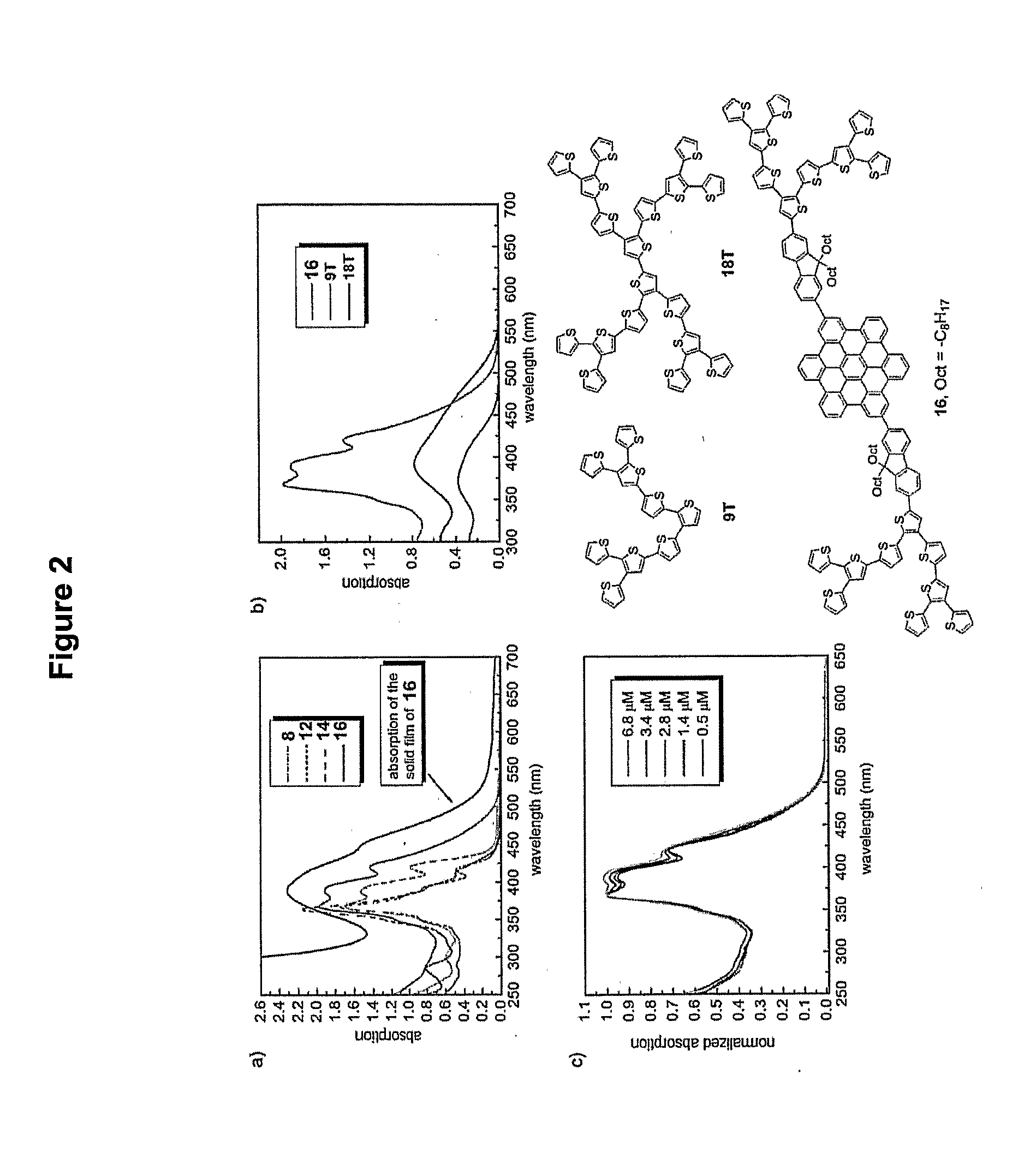Novel compounds, derivatives thereof and their use in heterojunction devices
- Summary
- Abstract
- Description
- Claims
- Application Information
AI Technical Summary
Benefits of technology
Problems solved by technology
Method used
Image
Examples
example 1
HBC Core 1 (See Scheme 3)
[0064]Compound 14 (1 g, 0.28 mmol) was dissolved in dry CH2Cl2 (250 mL) and the solution was degassed by bubbling argon through. A solution of iron(III) chloride (0.8 g, 5 mmol) in dry nitromethane (10 mL) was added to the solution with argon bubbling through the reaction. The reaction was stirred for 45 min at 25° C. and the solvent was removed under vacuum. The product was isolated as a yellow powder (0.9 g, 90% yield) after purification by column chromatography (SiO2, Pet. spirit 40-60 / CH2Cl2 4:1, Rf 0.5). m.p. 158-160° C.
[0065]1H NMR (500 MHz, CDCl3, δ): 0.76 (br m, 36H, —CH3), 0.84 (br m, 24H, —CH2—), 1.14 (br m, 120H, —CH2—), 2.14 (br m, 24H, —CH2—), 7.56 (br, 6H, ArH), 7.75-8.12 (br m, 30H, ArH), 9.31-9.64 (br m, 12H, ArH). 13C NMR (125 MHz, CDCl3, δ): 14.3, 22.9, 24.2, 29.5, 30.2, 30.4, 32.0, 40.7, 55.9, 93.1, 120.9, 122.0, 122.4, 127.4, 131.2, 132.5, 136.4, 140.5, 141.3, 151.7, 153.7. MS-MALDI (m / z): M+ 3609.4. Elemental analysis: cal. C, 71.87; H, ...
example 2
HBC Core 2 (See Scheme 4)
[0066]To a degassed solution of compound 16 (1.5 g, 1 mmol) in CH2Cl2 (50 mL) was added FeCl3 (1 g in 5 mL of MeNO2). The reaction was allowed to stir for 5 h with argon bubbling through the reaction. Methanol (10 mL) was added and the product was extracted with CH2Cl2. A yellow crystalline solid (1 g, 64% yield) was isolated after column chromatography (SiO2, CH2Cl2 / pet. spirits 40-60° C. 1:3, Rf 0.25) and recrystallisation from CH2Cl2. m.p. >250° C.
[0067]1H NMR (500 MHz, CDCl3): 0.84 (t, J 7, 12H, —CH3), 0.99 (br, 4H, —CH2—), 1.08 (br, 4H, —CH2—), 1.27 (m, 40H, —CH2—), 2.26 (m, 8H, —CH2—), 7.06 (t, J 7, 2H, ArH), 7.18 (t, J 7, 2H, ArH), 7.54 (d, J 7, 2H, ArH), 7.62 (m, 4H, ArH), 7.77-7.83 (m, 12H, ArH), 7.89 (m, 2H, ArH), 7.91 (m, 2H, ArH), 7.99 (br s, 2H, ArH). 13C NMR (125 MHz, CDCl3, δ): 14.2, 22.7, 24.2, 29.3 (2), 29.4 (2), 29.5, 30.3, 31.9 (2), 40.6, 55.6, 92.6, 117.3, 117.7, 117.8, 118.1 (2), 119.6 (2), 119.7, 119.8, 119.9, 120.2, 121.2, 121.6, 121.8...
example 3
HBC Core 3 (See Scheme 5)
[0068]Compound 19 (2 g, 1.3 mmol) was dissolved in CH2Cl2 (500 mL) with argon bubbling through the solution. FeCl3 (3.8 g, 24 mmol) in nitromethane (20 mL) was added and the solution was stirred at 25° C. for 1 h with argon bubbling through the solution. Methanol (300 mL) was added and the CH2Cl2 was removed in vacuo. The precipitate was collected and washed with methanol and petroleum spirits. The residue was dissolved in CH2Cl2 and precipitated in diethyl ether. The precipitate was again collected and washed with diethyl ether and petroleum spirits. An orange solid (1.7 g, 83% yield) was obtained after drying in vacuo. m.p. >250° C.
[0069]1H NMR (500 MHz, CDCl3, δ): 0.86 (t, J 7, 12H, CH3), 0.98 (br, 8H, CH2), 1.26 (m, 40H, CH2), 2.19 (m, 8H, CH2), 6.99 (m, 4H, ArH), 7.34 (d, J 7, 2H, ArH), 7.53 (d, J 8, 2H, ArH), 7.57 (br, 4H, ArH), 7.63 (d, J 7, 2H, ArH), 7.72 (m, 6H, ArH), 7.87 (m, 4H, ArH), 7.97 (s, 4H, ArH). 13C NMR (125 MHz, CDCl3, δ): 14.2, 22.7, 24....
PUM
| Property | Measurement | Unit |
|---|---|---|
| Volume | aaaaa | aaaaa |
| Volume | aaaaa | aaaaa |
| Mass | aaaaa | aaaaa |
Abstract
Description
Claims
Application Information
 Login to View More
Login to View More - R&D
- Intellectual Property
- Life Sciences
- Materials
- Tech Scout
- Unparalleled Data Quality
- Higher Quality Content
- 60% Fewer Hallucinations
Browse by: Latest US Patents, China's latest patents, Technical Efficacy Thesaurus, Application Domain, Technology Topic, Popular Technical Reports.
© 2025 PatSnap. All rights reserved.Legal|Privacy policy|Modern Slavery Act Transparency Statement|Sitemap|About US| Contact US: help@patsnap.com



